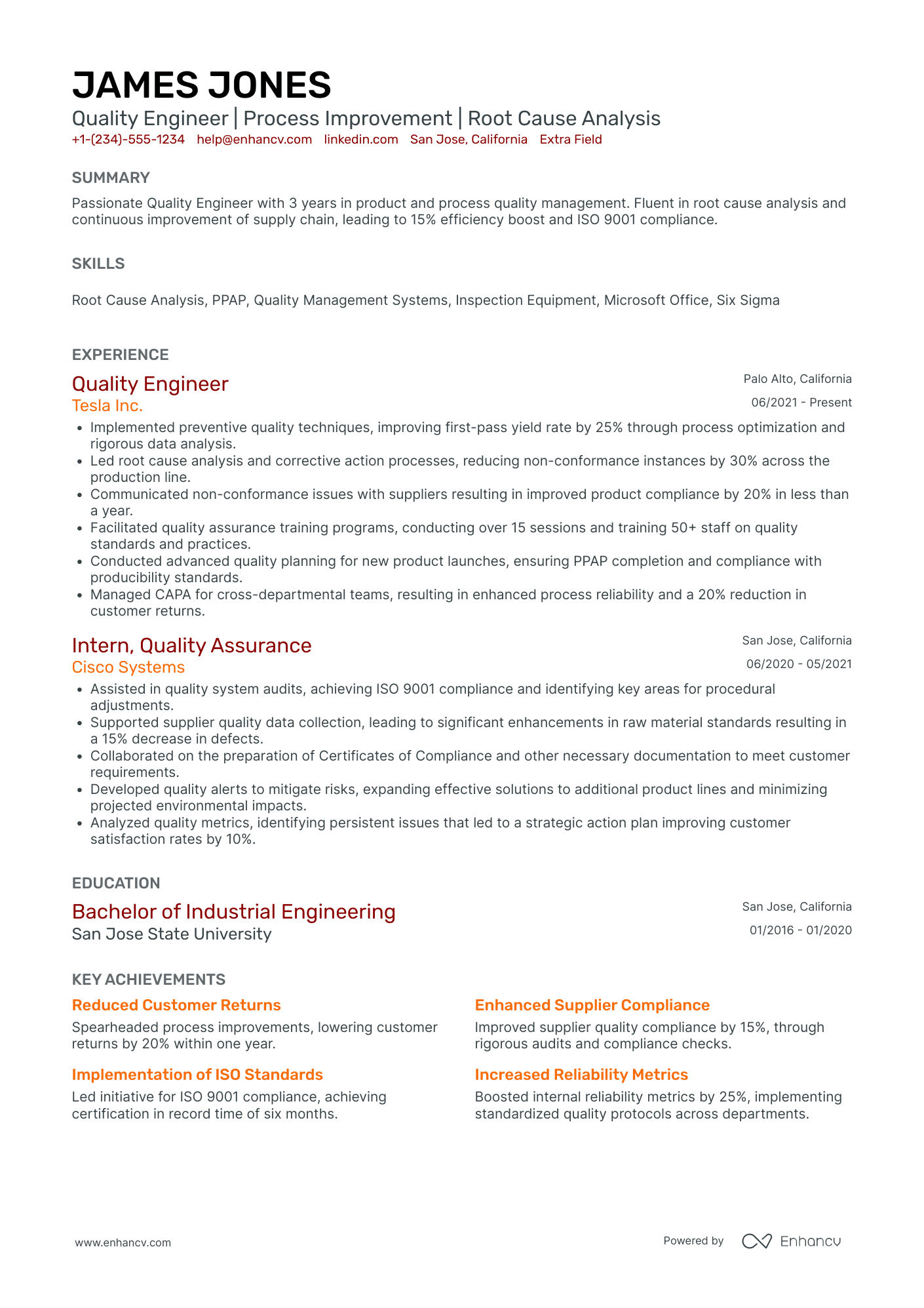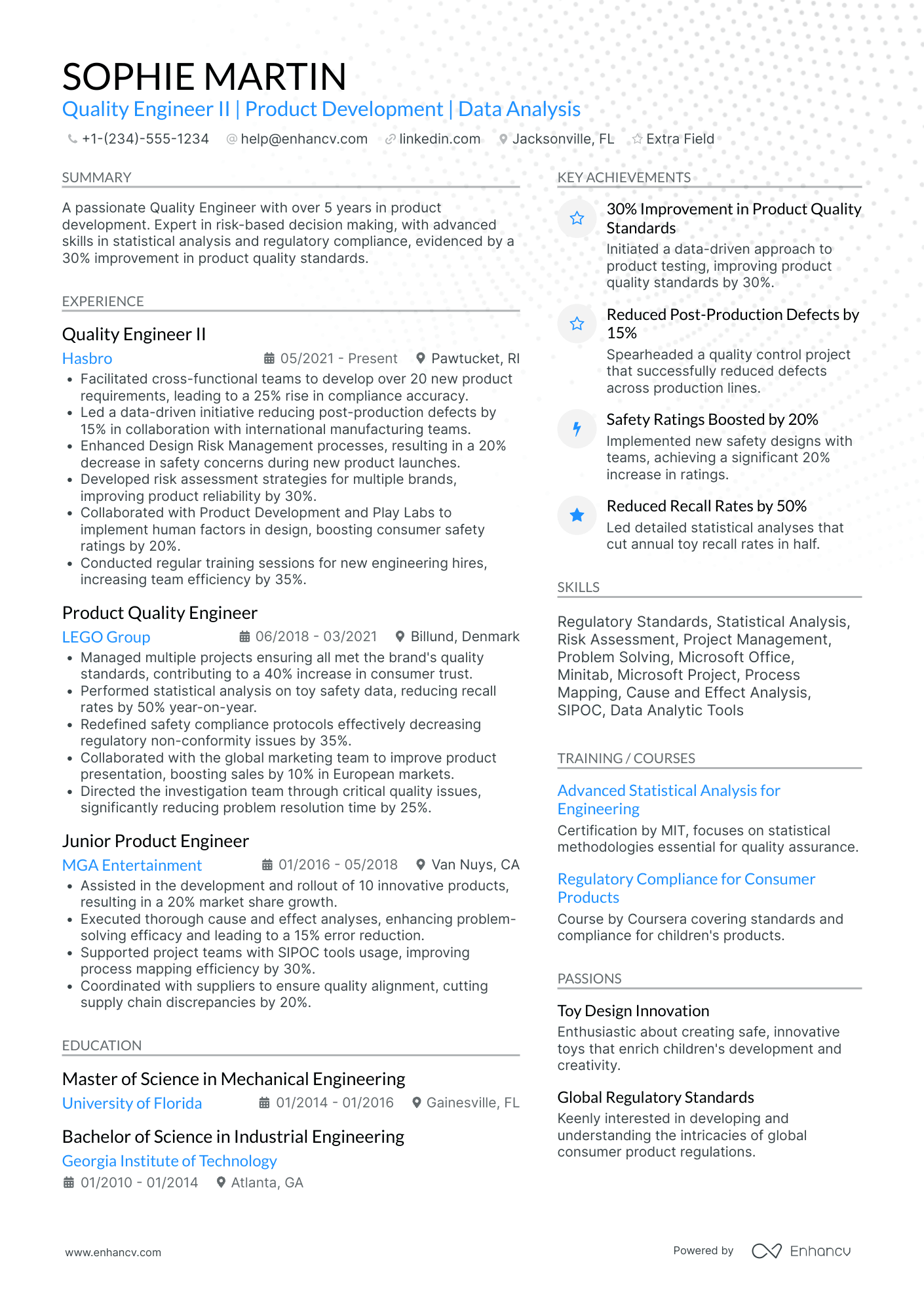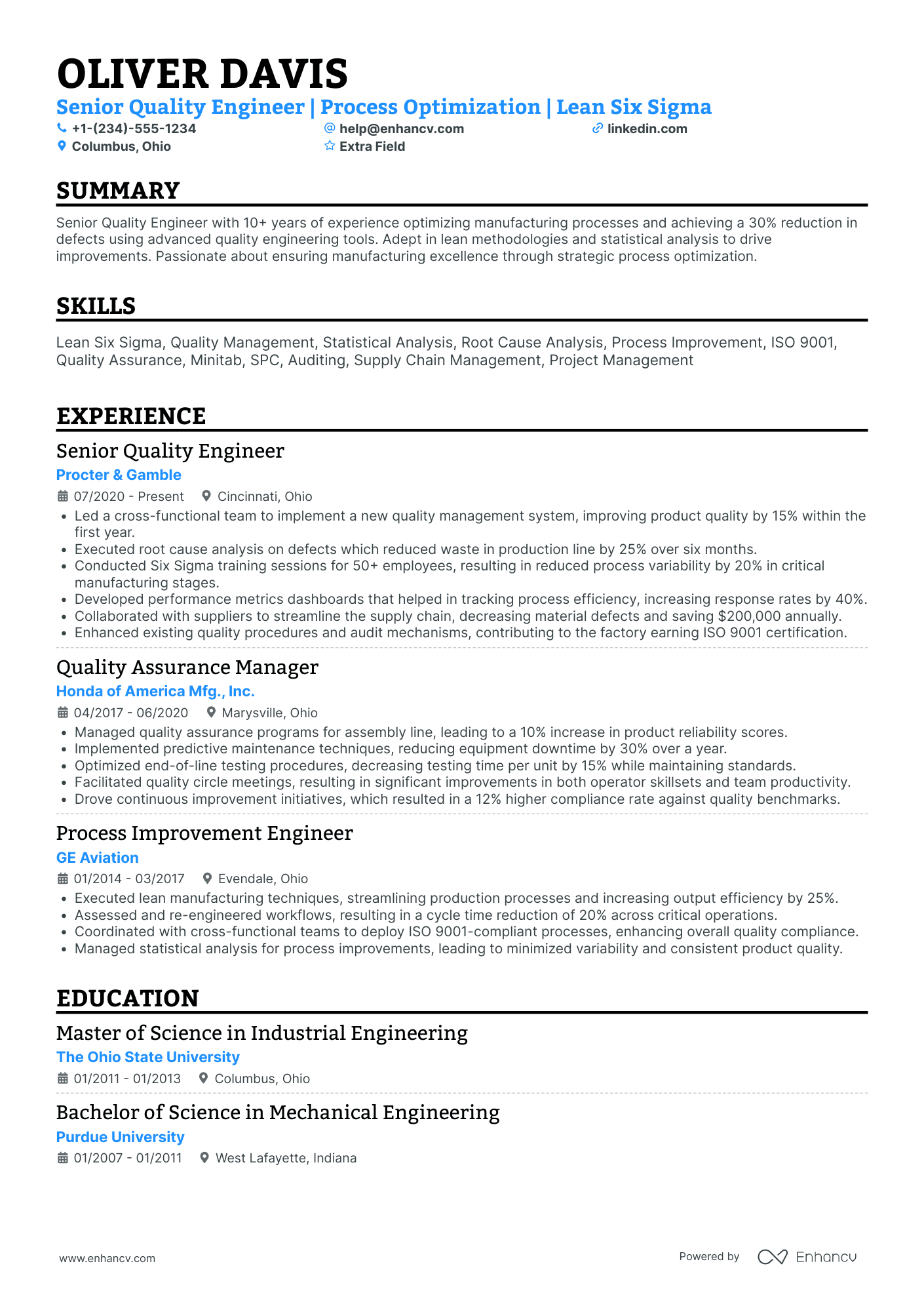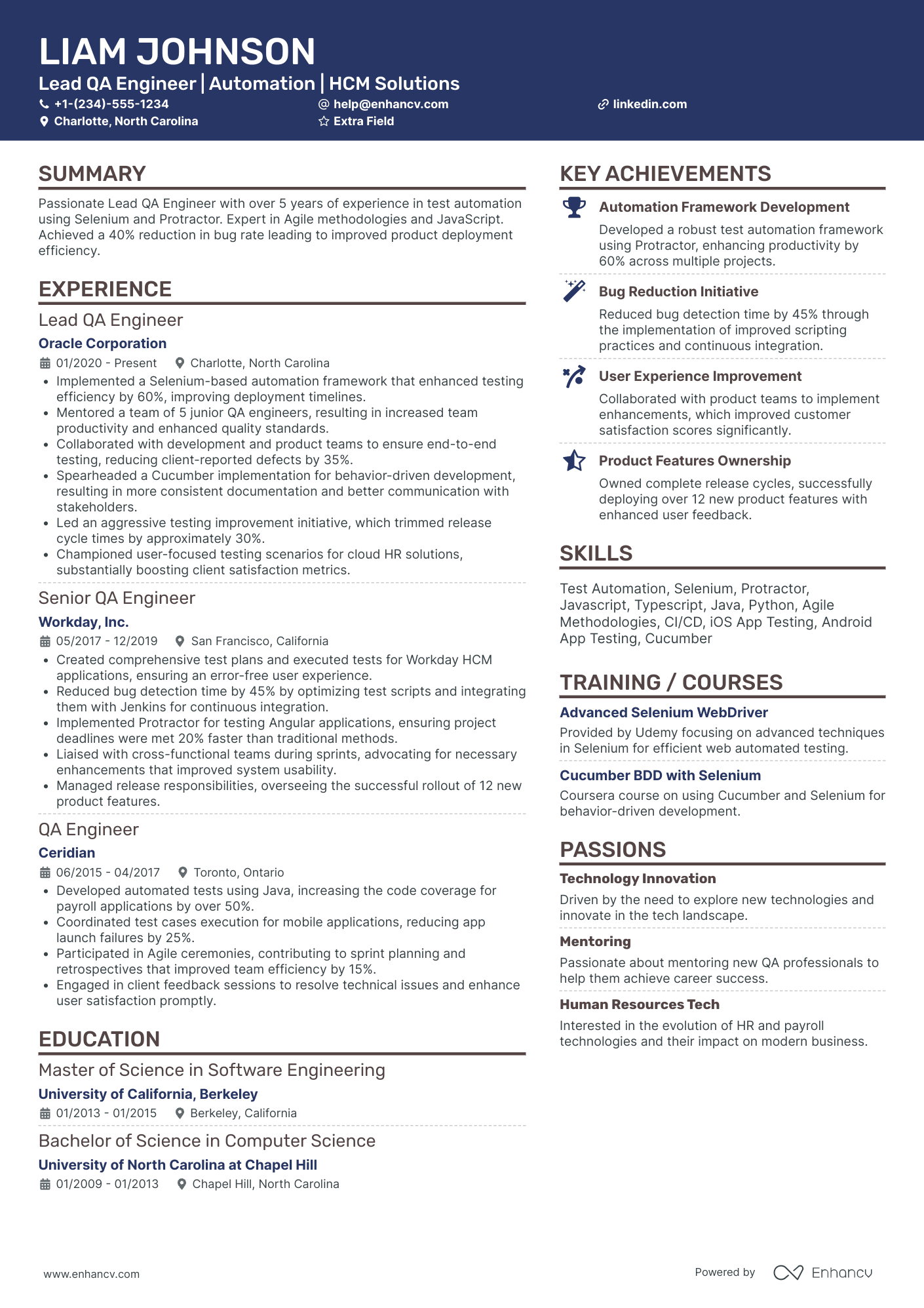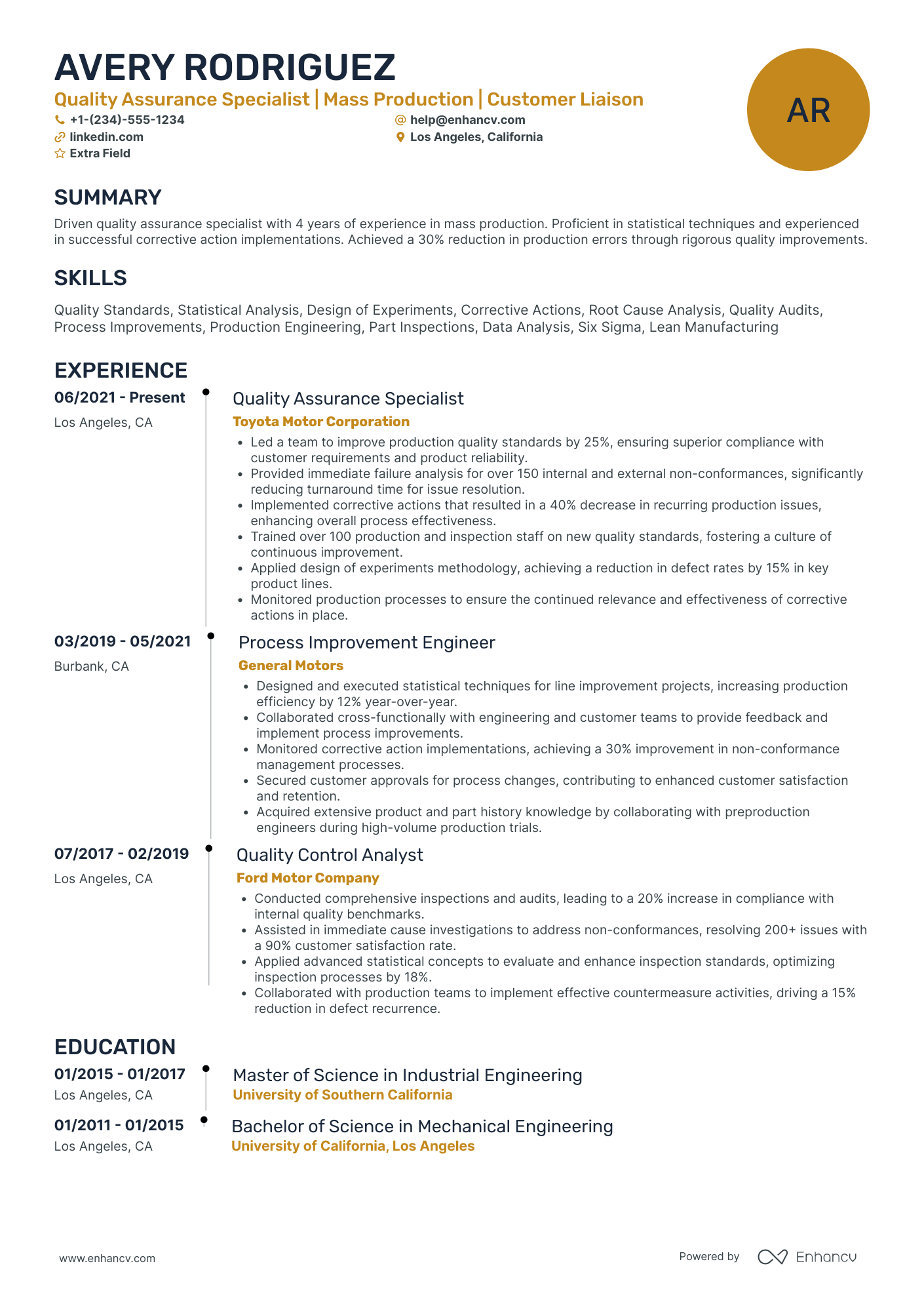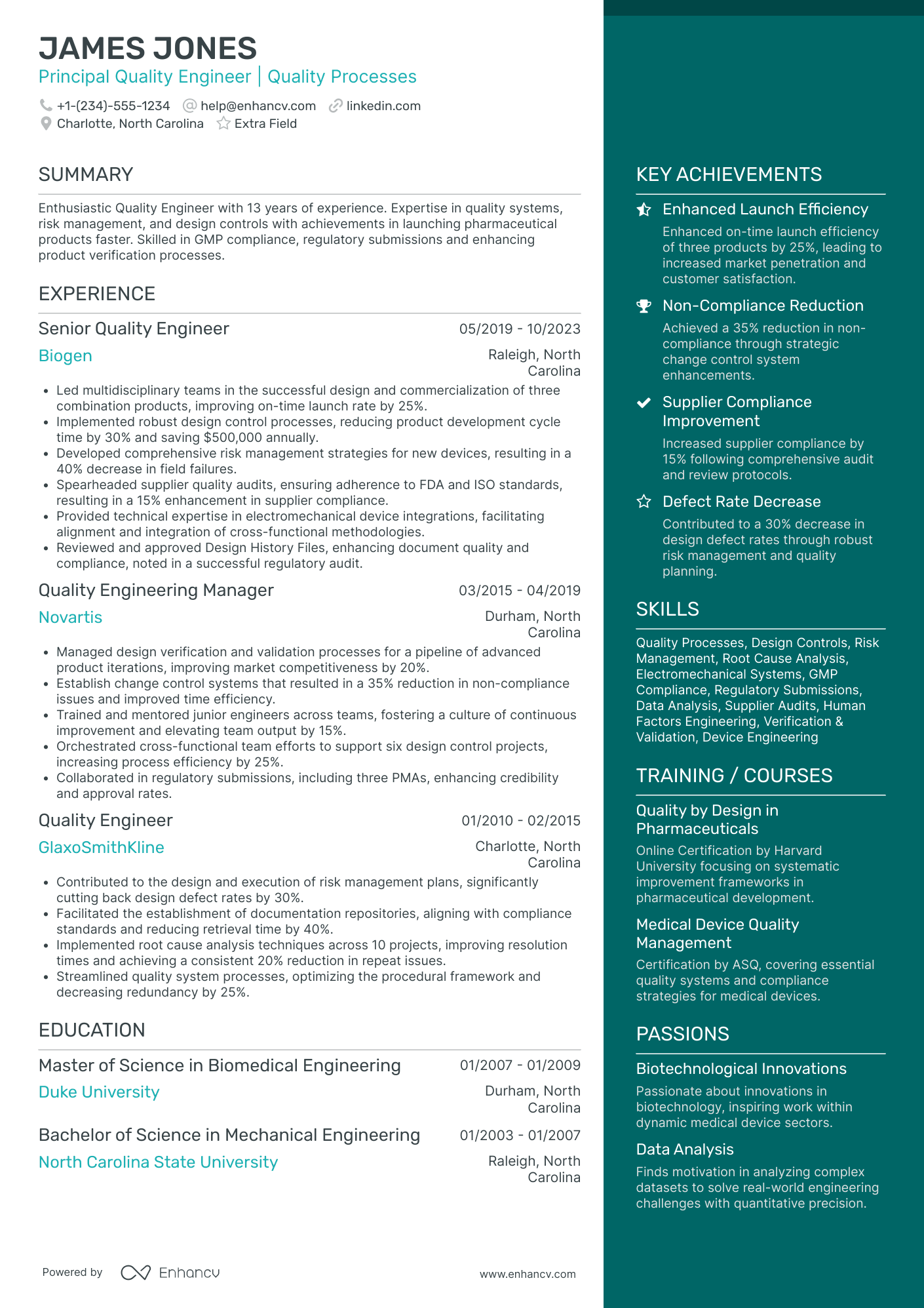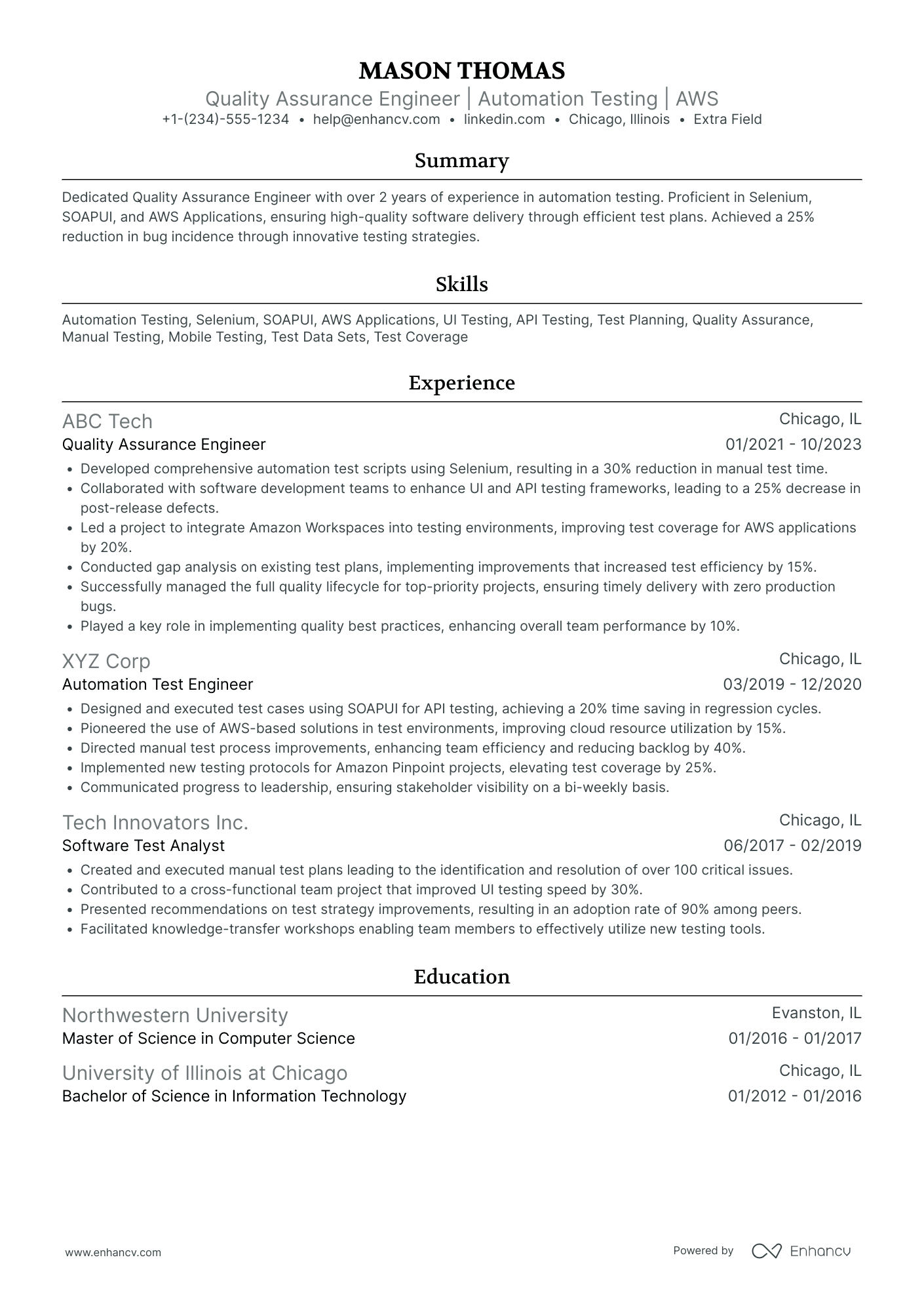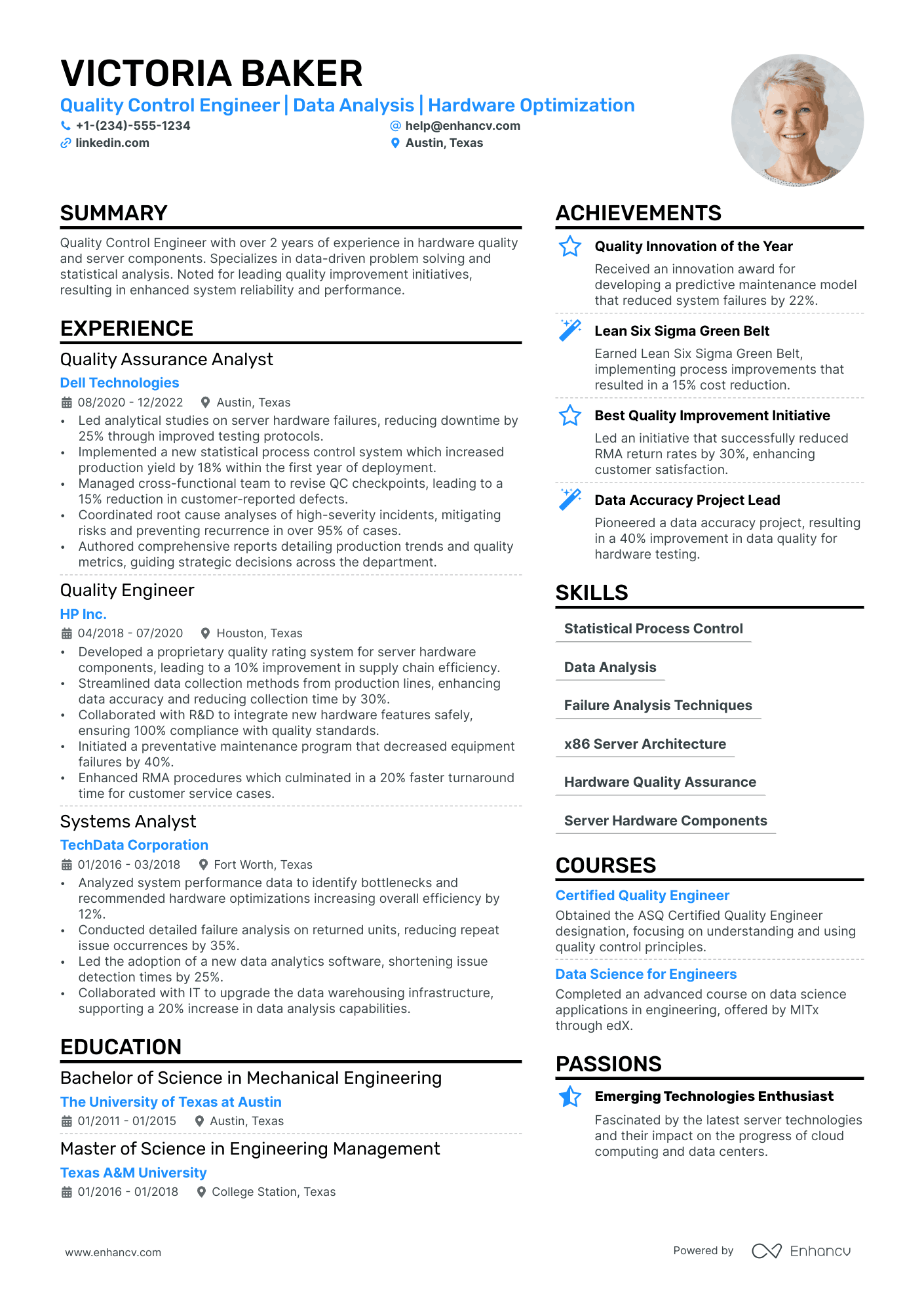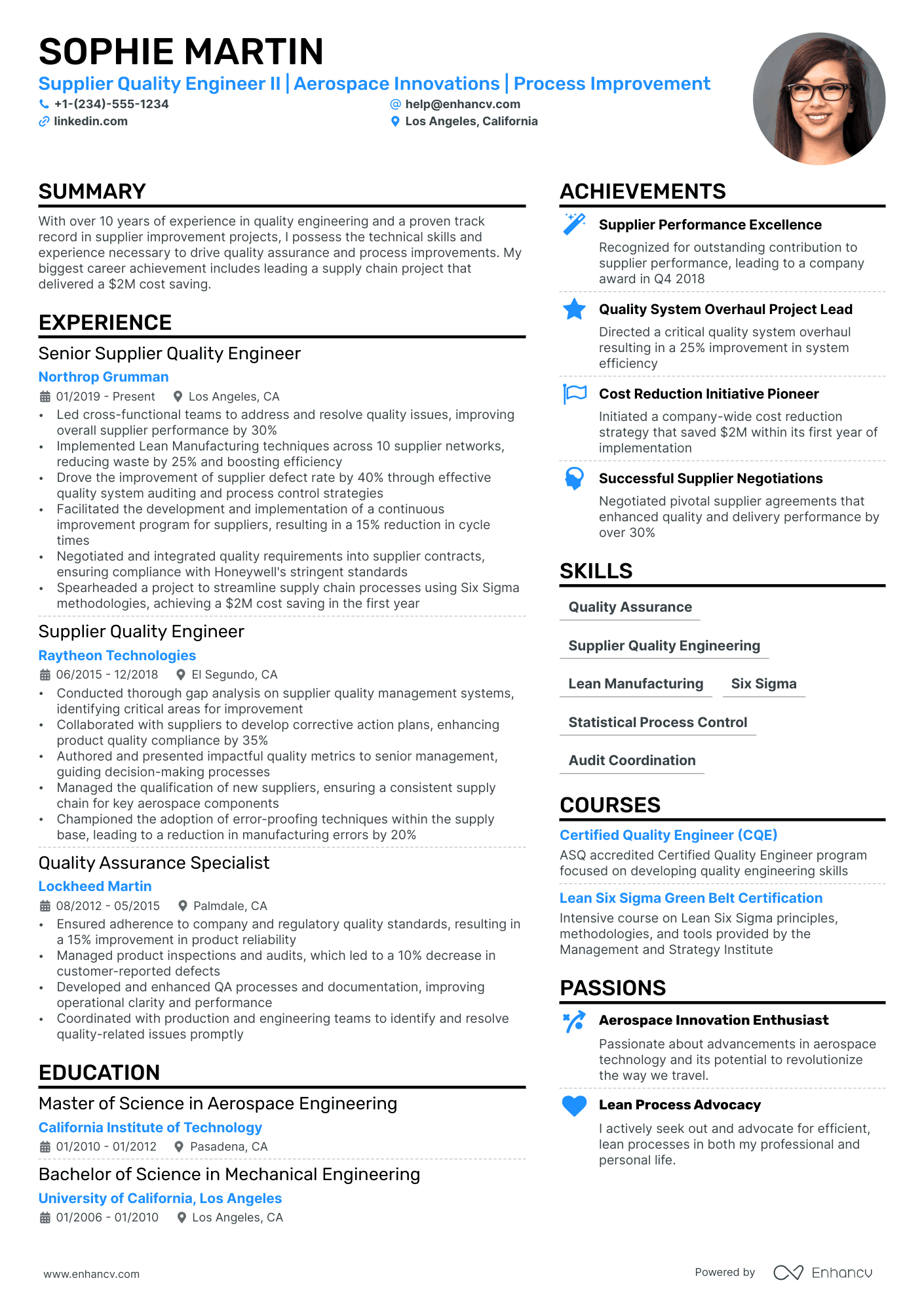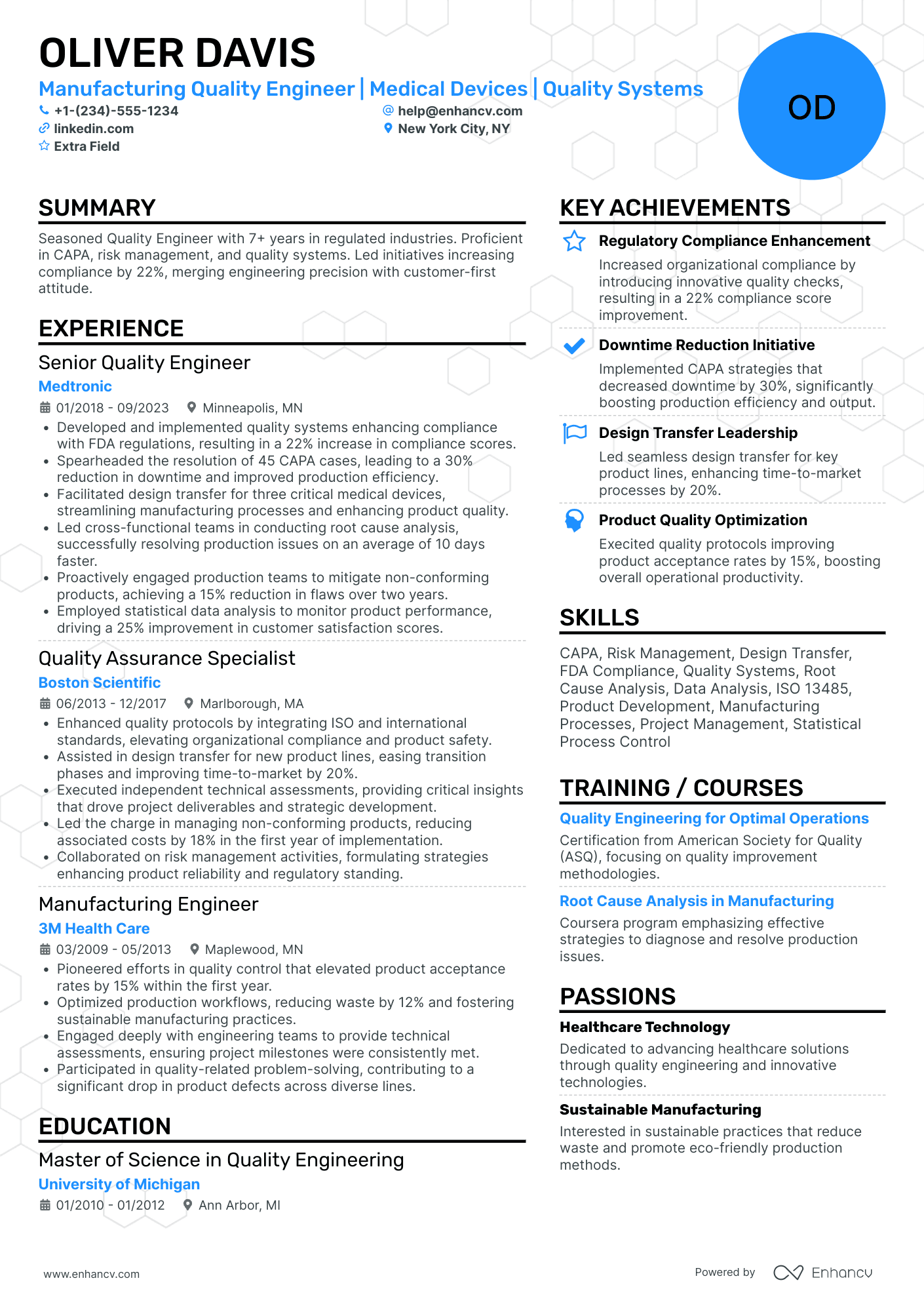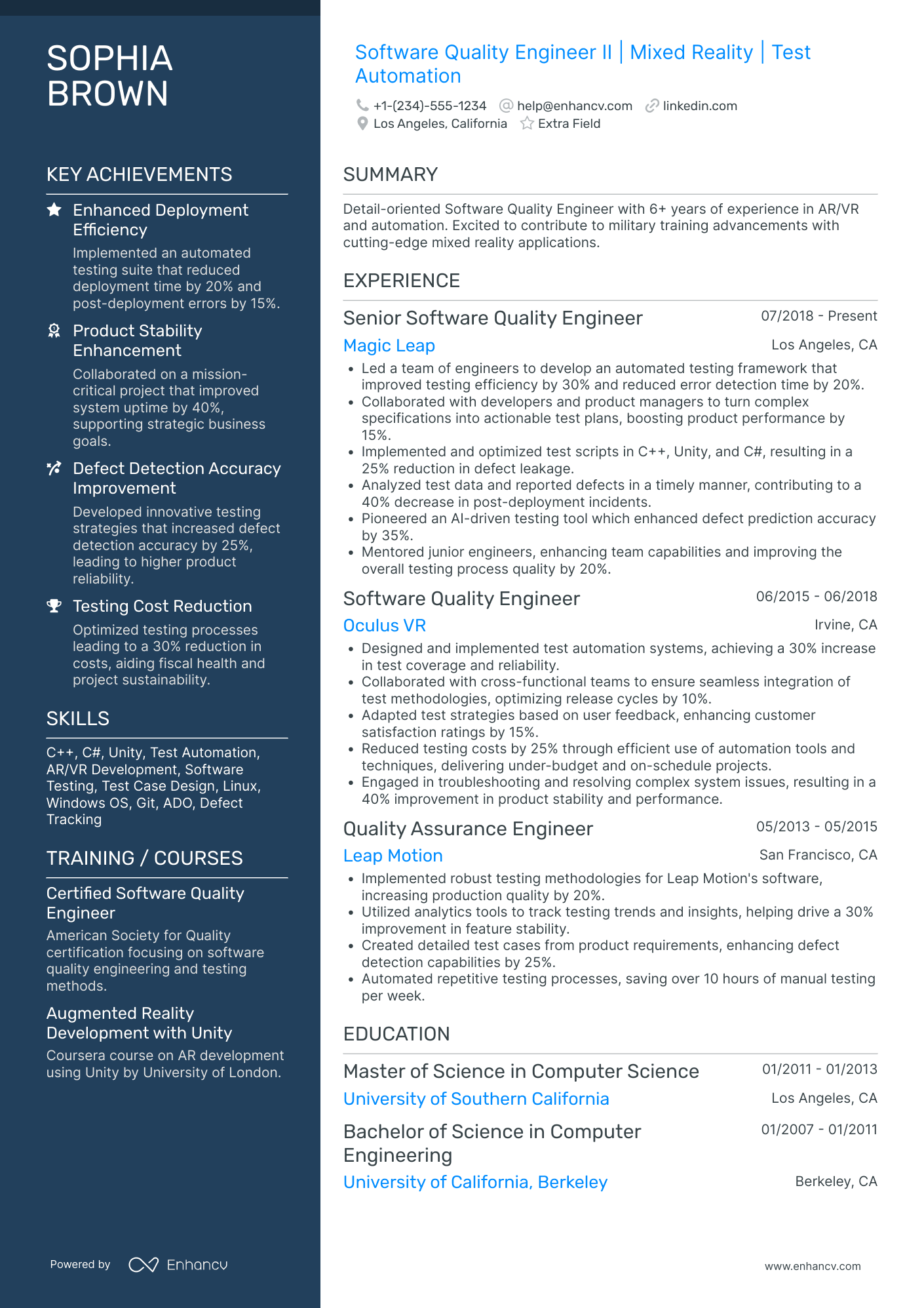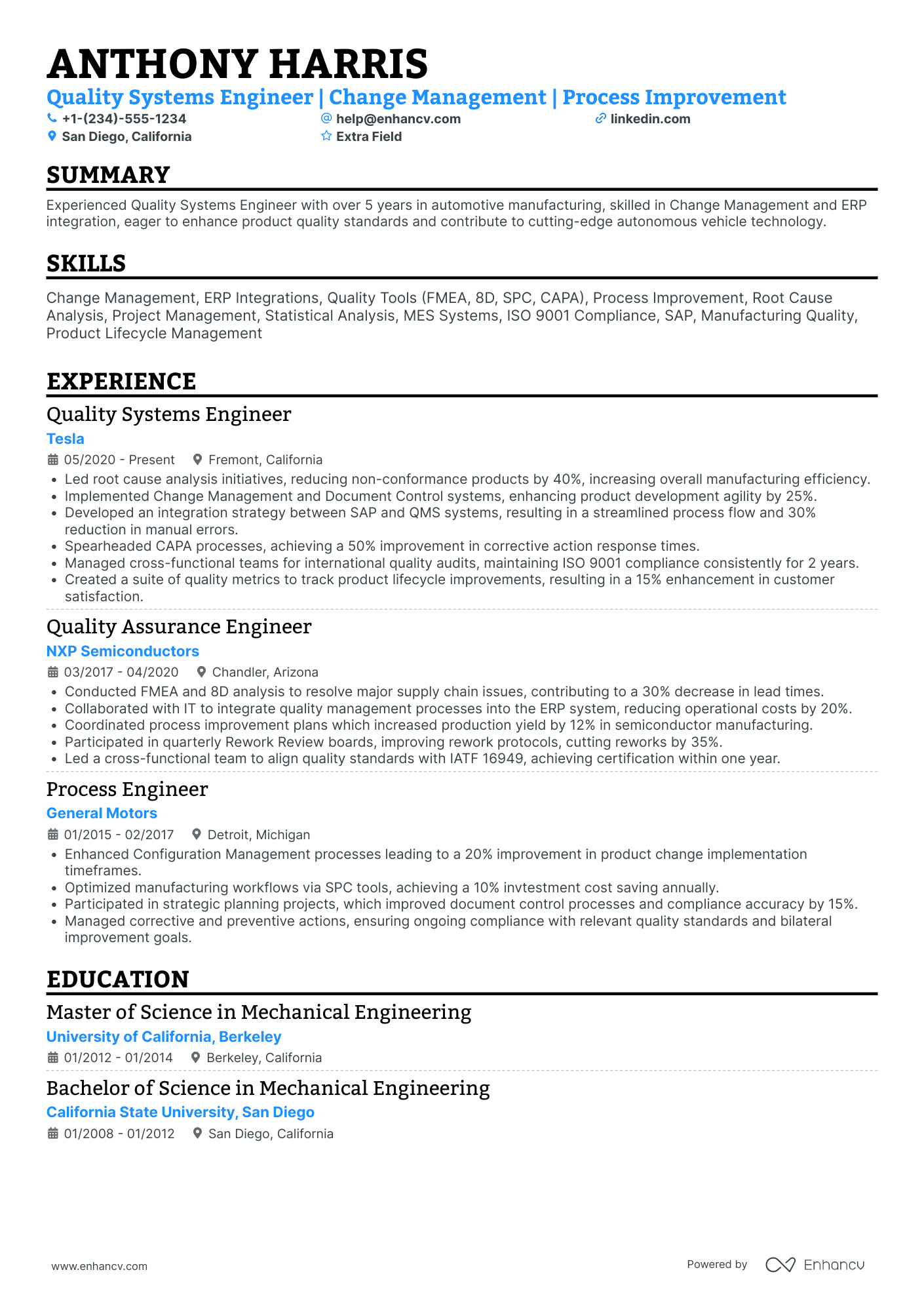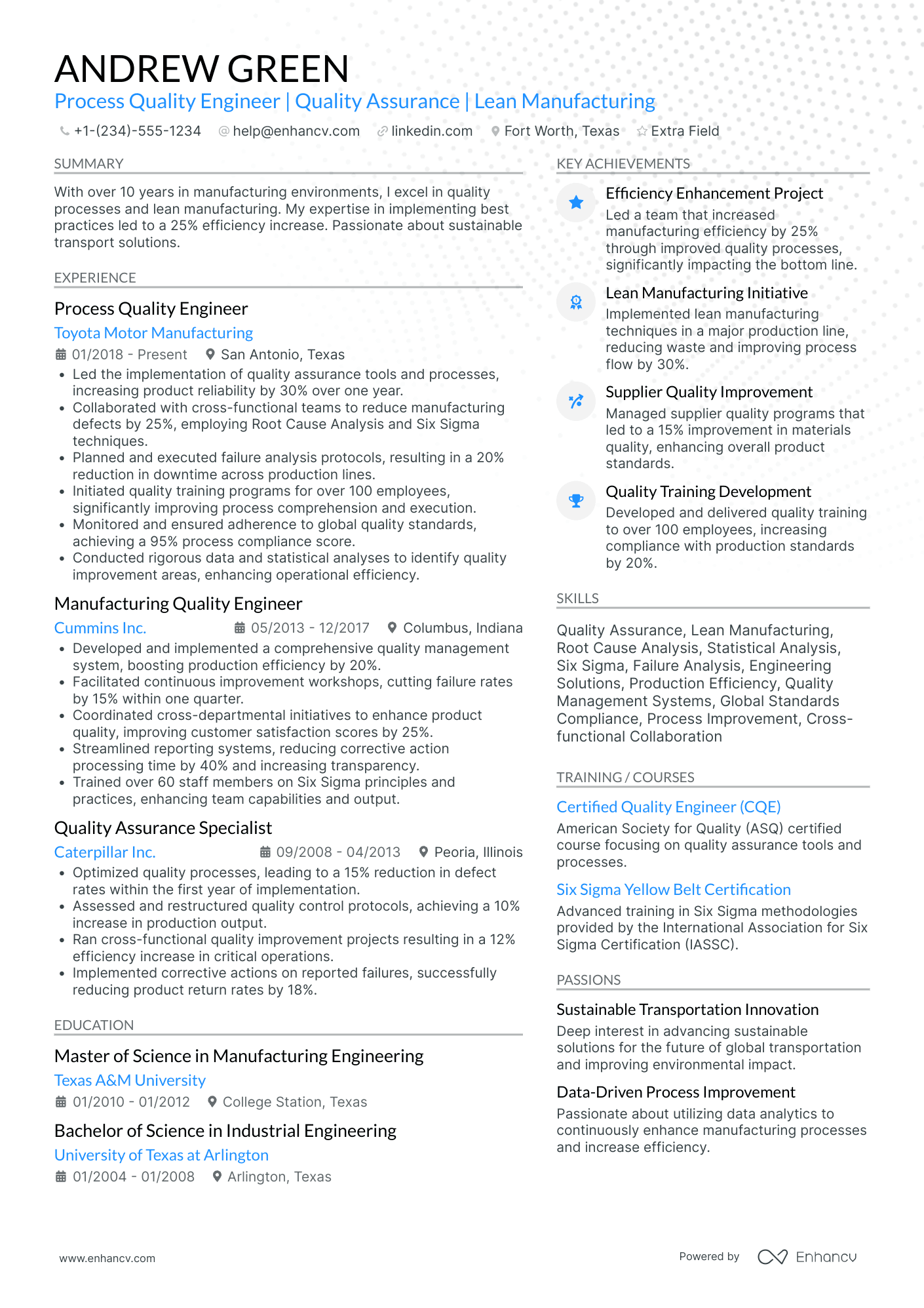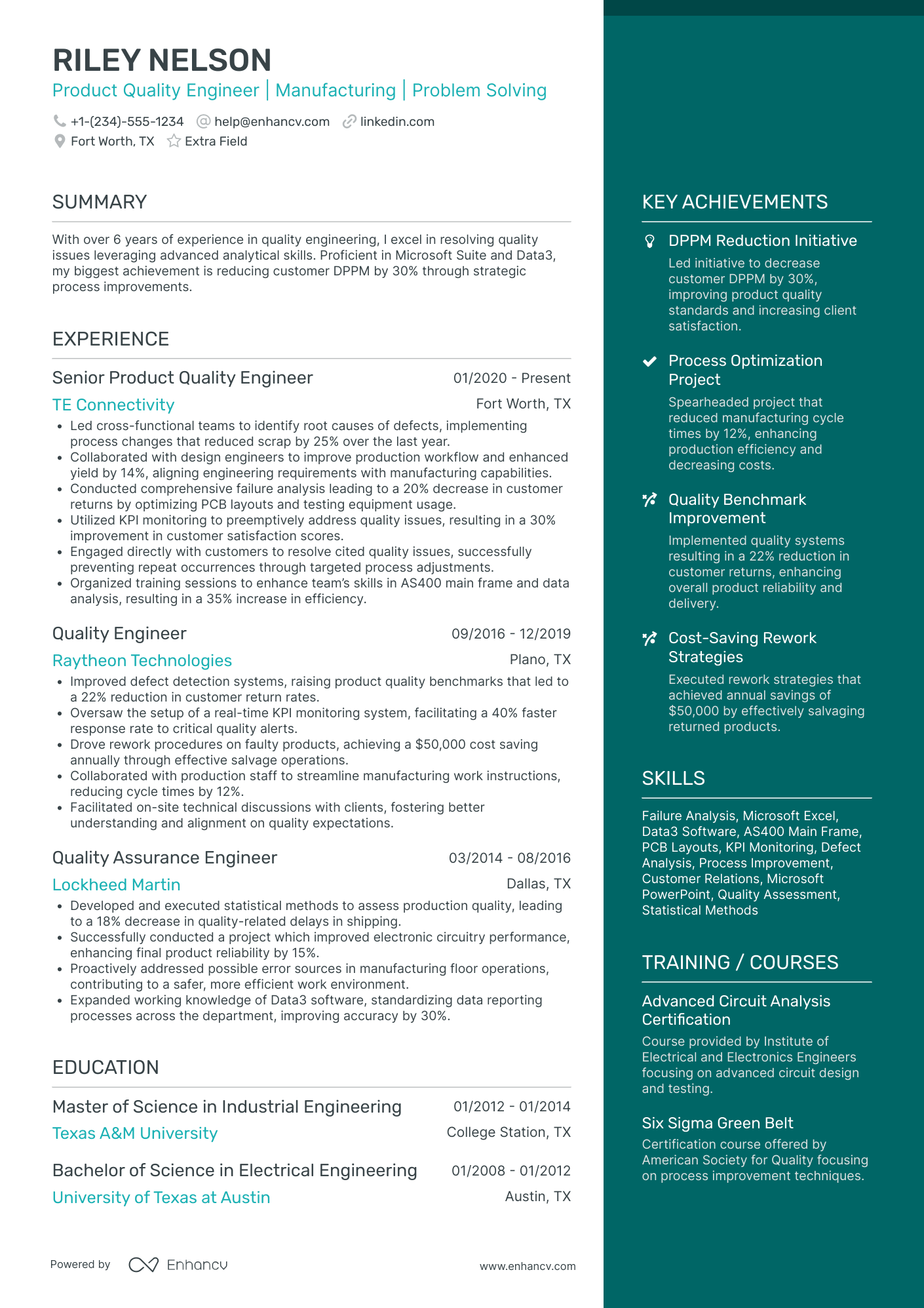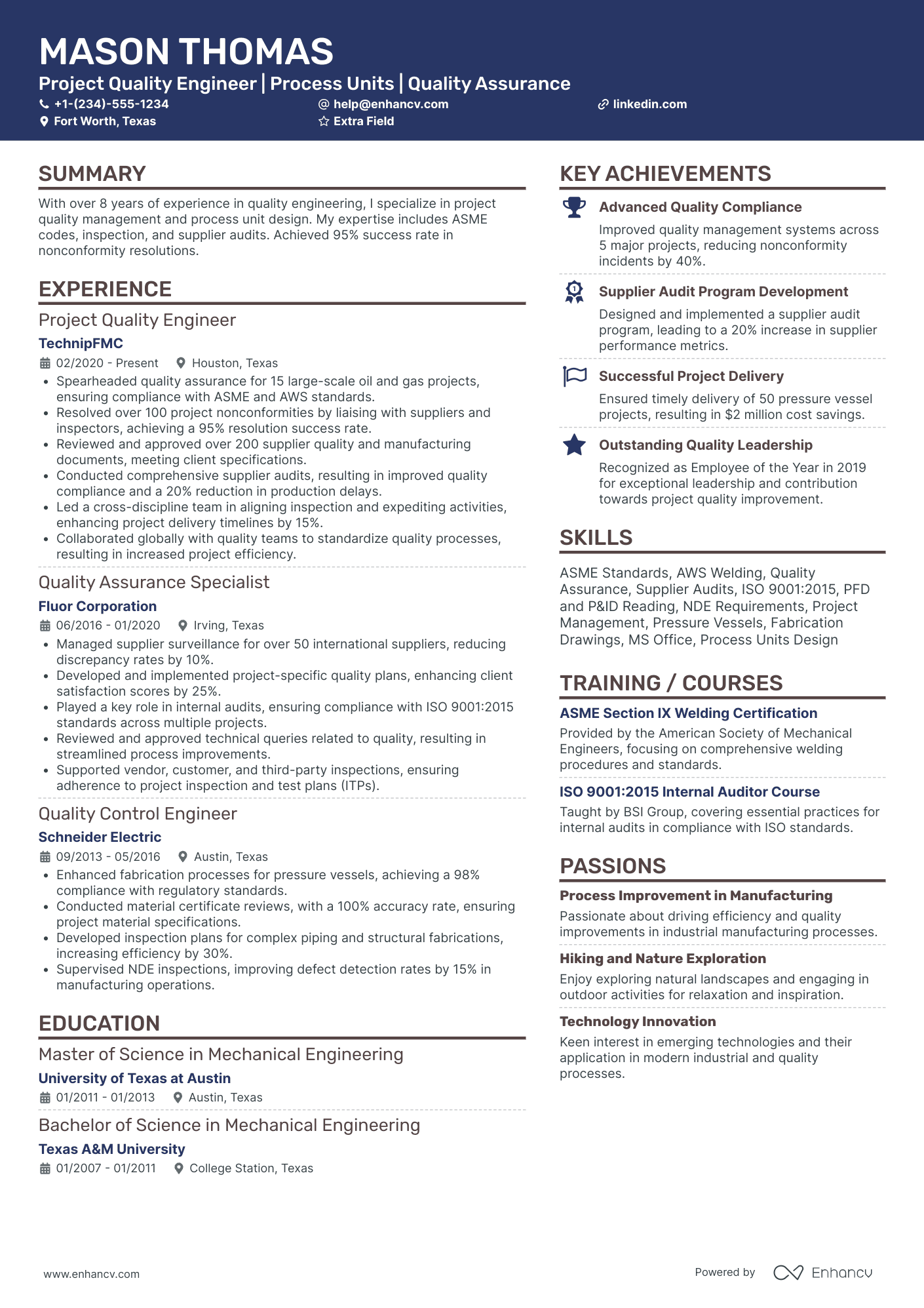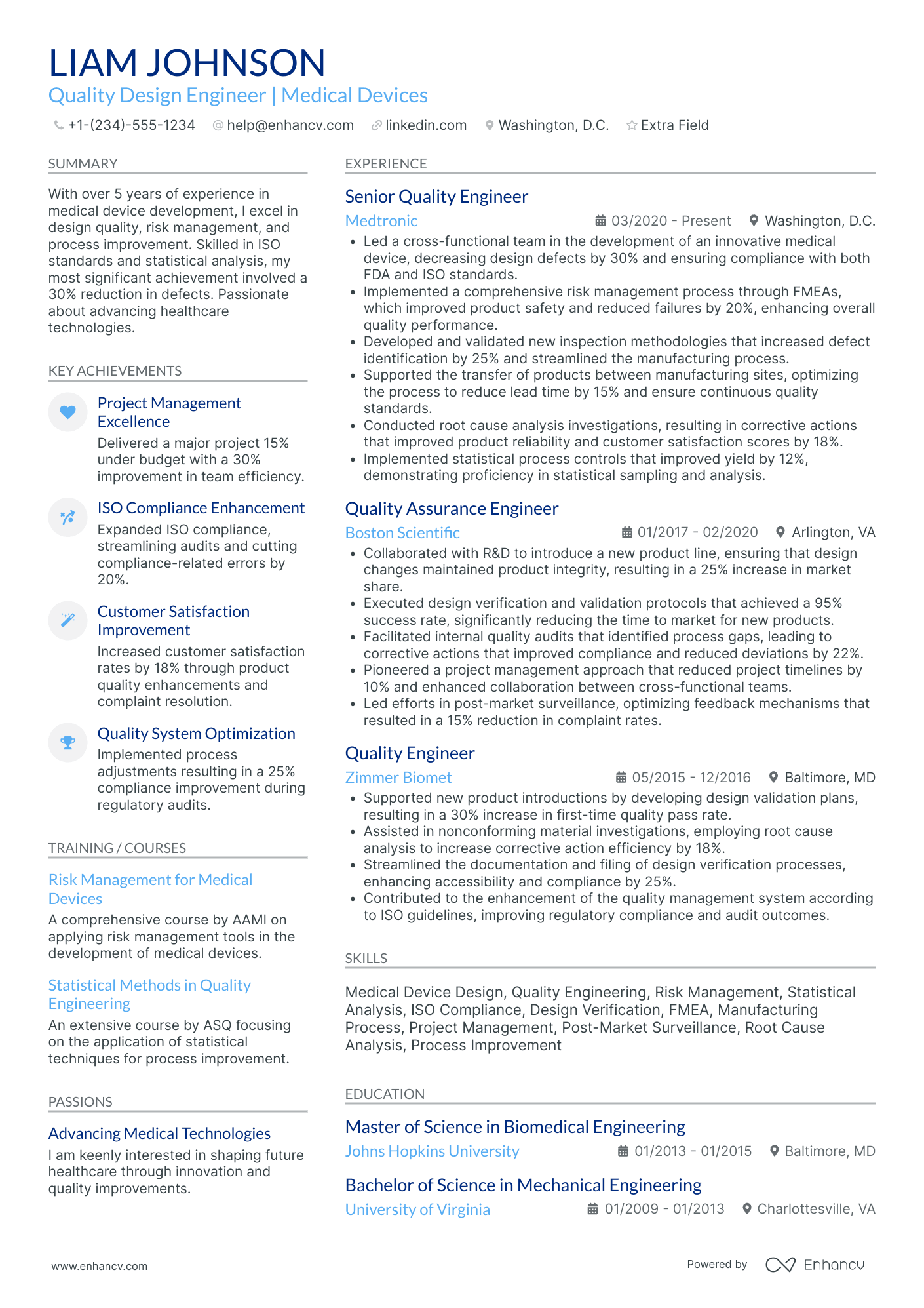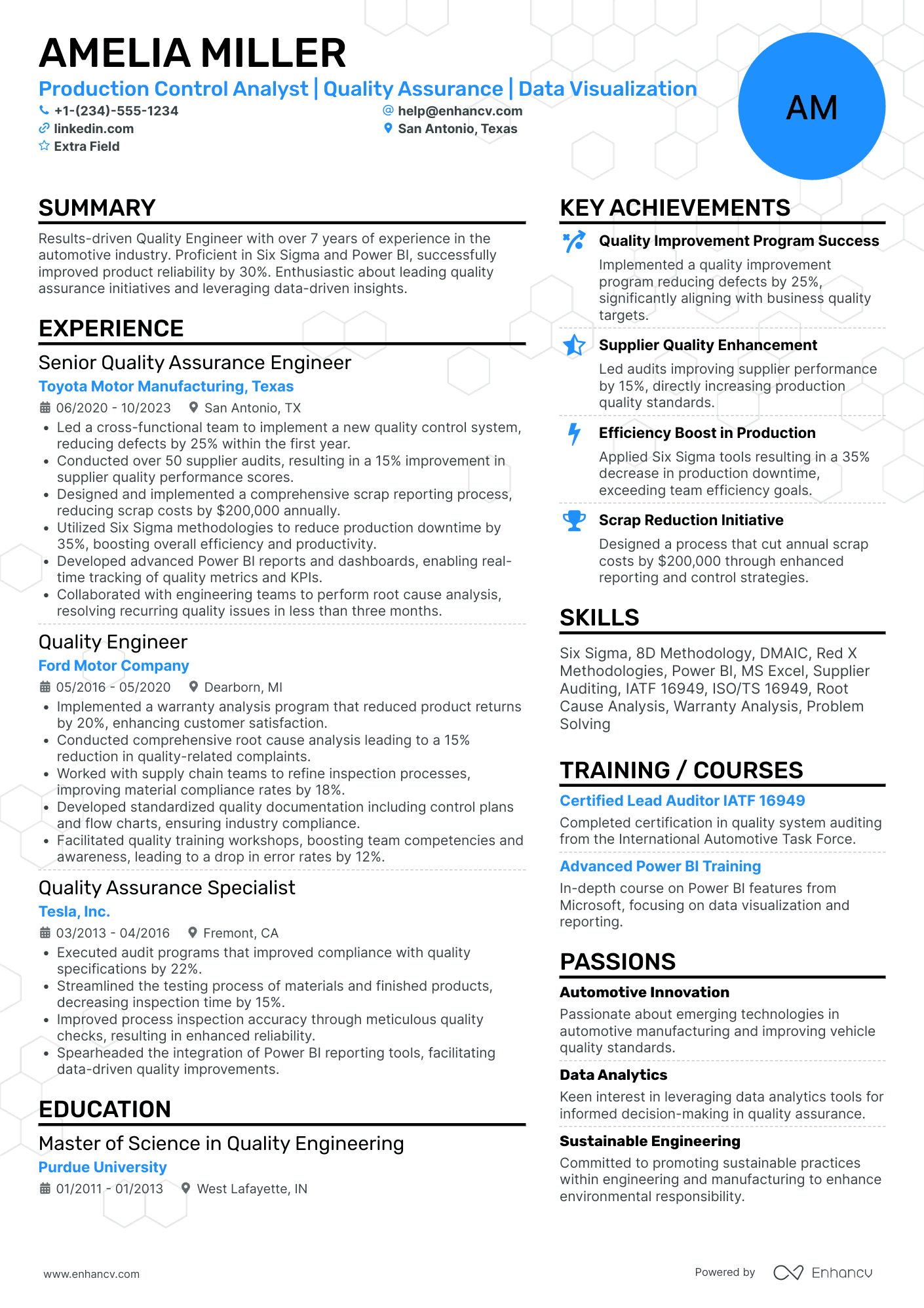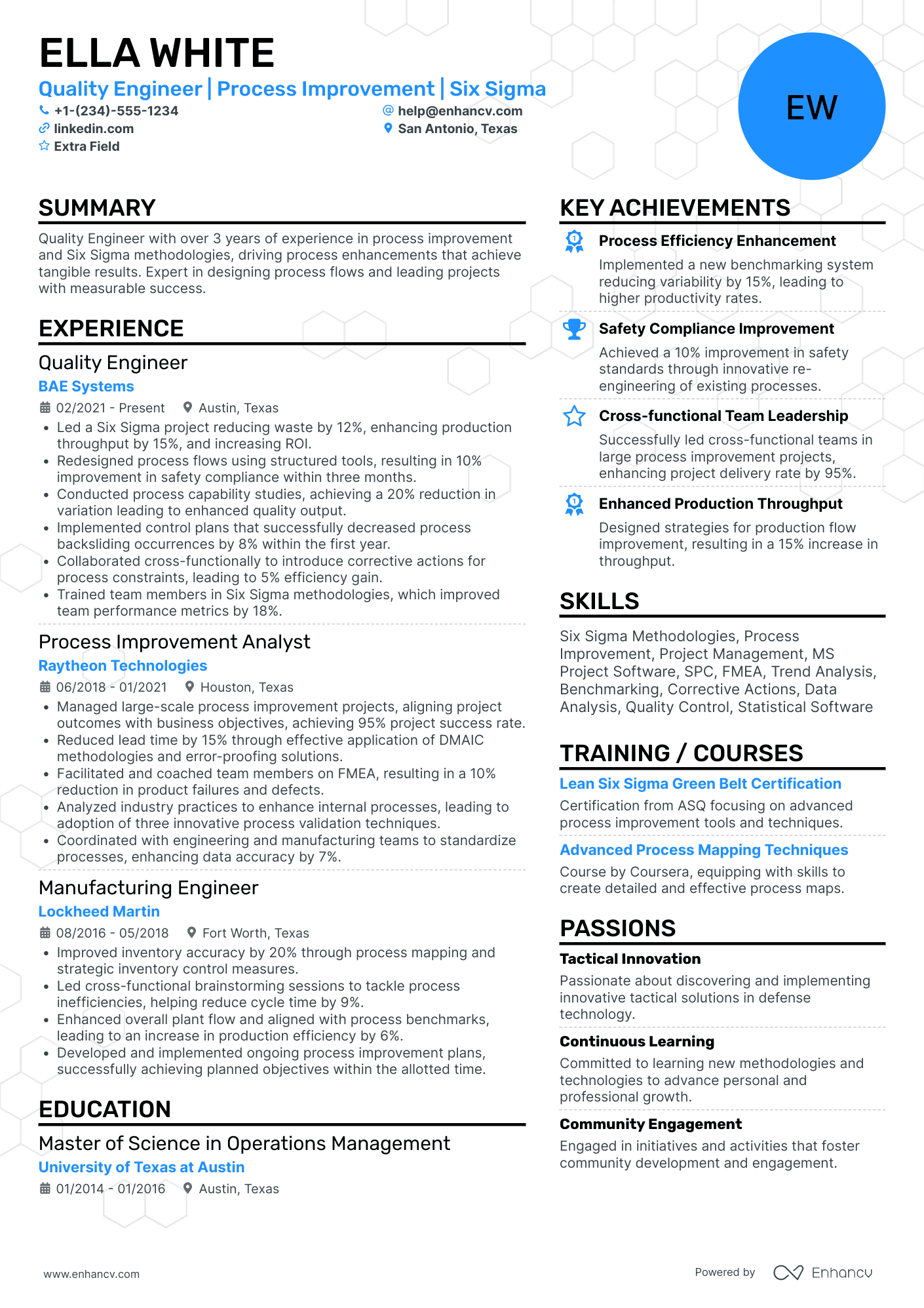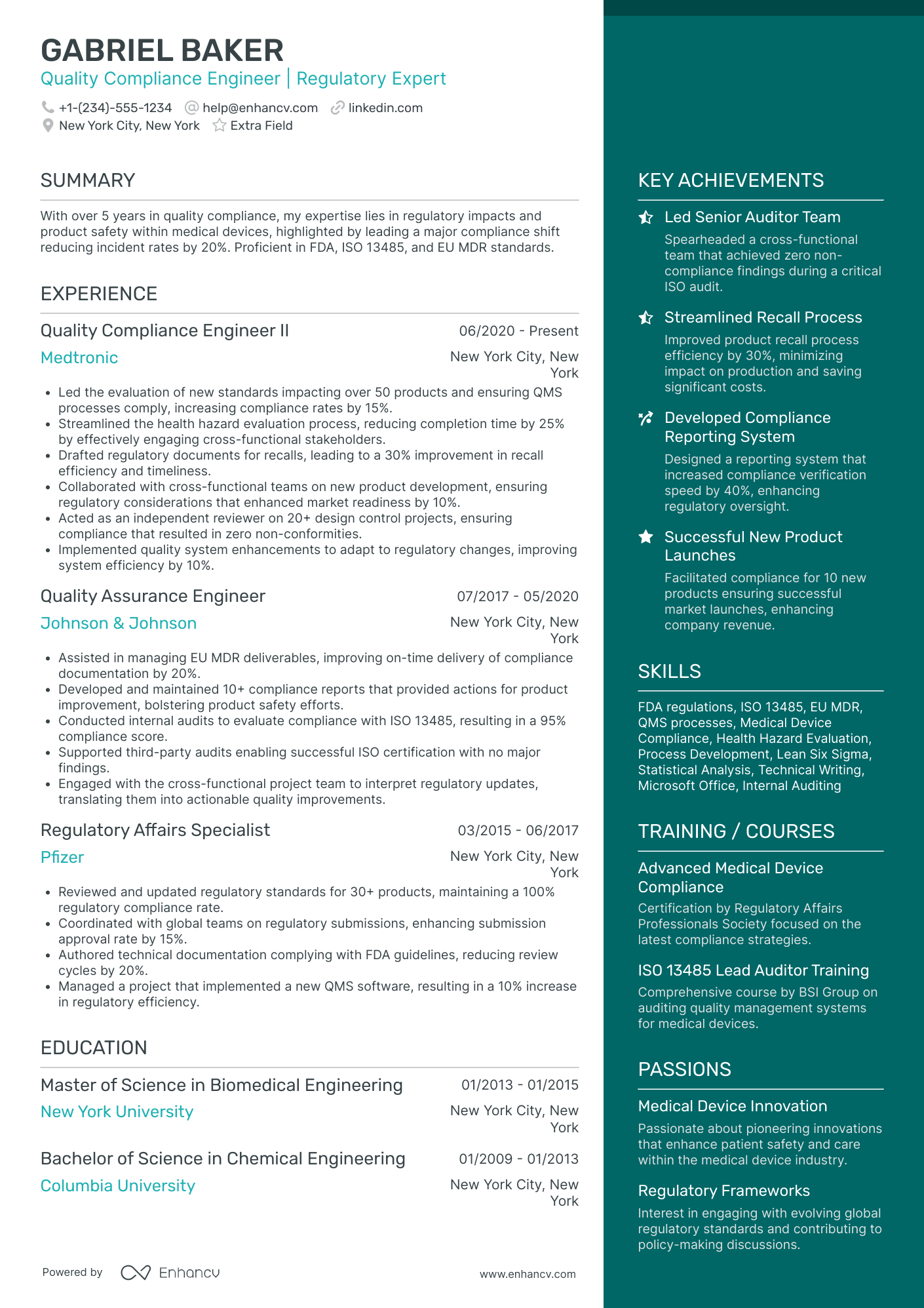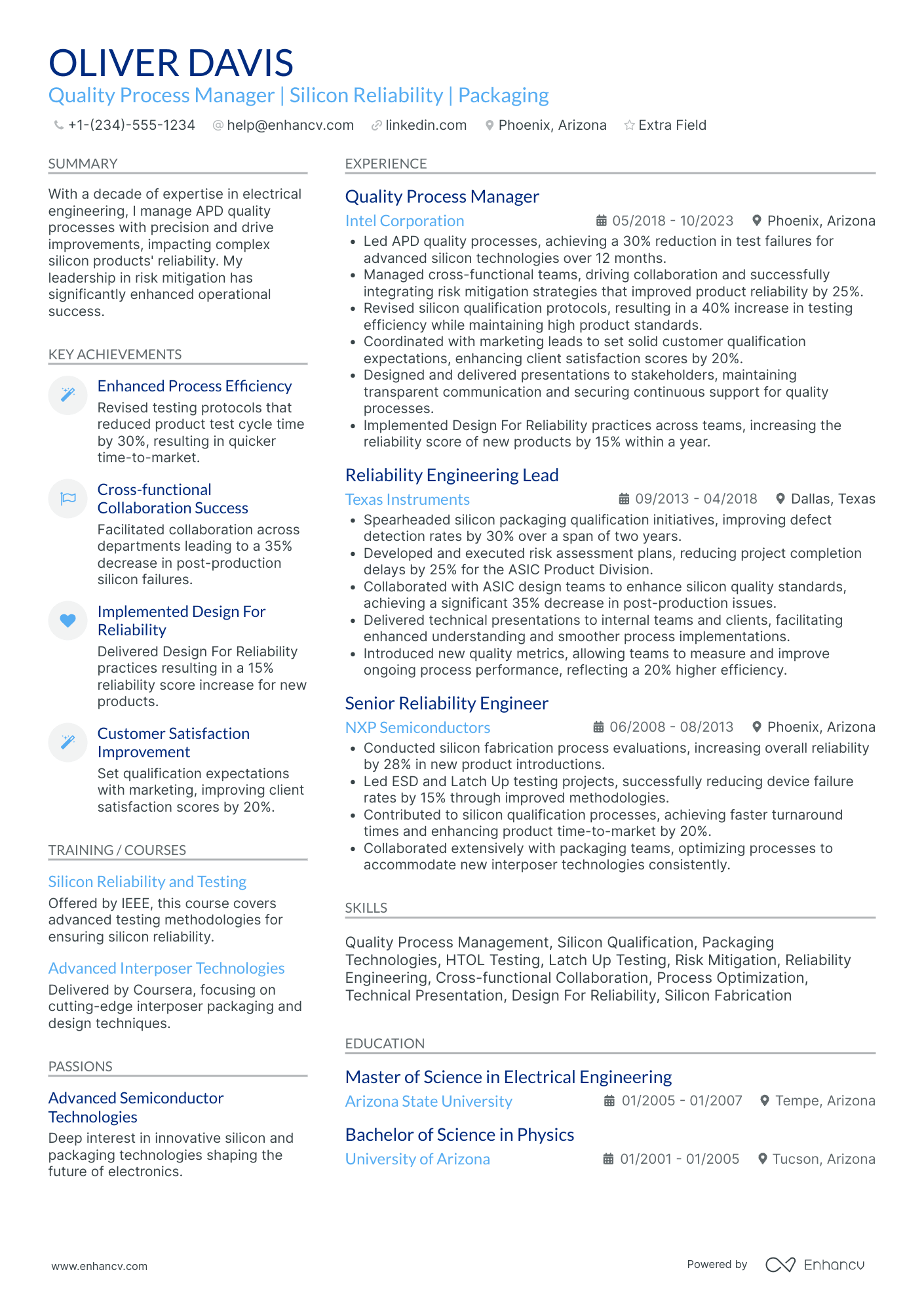Breaking into the quality engineering field is more competitive than ever. The U.S. manufacturing industry is projected to need 3.8 million jobs by 2033. However, 1.9 million of those positions could go unfilled due to skill gaps, leading companies to seek candidates who can make an immediate impact.
Quality engineers—professionals who develop and implement systems to ensure products meet consistent, high-quality standards—are essential to ensuring products meet rigorous standards while improving processes to increase efficiency—skills in demand across industries like manufacturing, technology, and healthcare.
Your resume is your chance to demonstrate your ability to bridge this skills gap by presenting expertise in quality assurance, problem-solving, and process optimization.
Key takeaways
- Present expertise in ISO 9001 compliance, root cause analysis, and quality management systems.
- Use measurable results, such as “reducing defects by 25% or improving efficiency by 18%, to emphasize your contributions.”
- Incorporate certifications like ASQ CQE and Six Sigma Green Belt to illustrate your technical skills.
- Include additional sections, such as projects, affiliations, or awards, to set yourself apart from other candidates.
Now that you know what makes quality engineering such a sought-after profession, let’s dive straight into a standout quality engineer resume sample. This example showcases the key elements recruiters are looking for, giving you a solid foundation to build your own winning resume.
Quality engineer resume sample
Here’s a tailored quality engineer resume for Lucas Rodriguez that effectively demonstrates the technical expertise, problem-solving skills, and measurable achievements employers look for in this role.
Lucas Rodriguez
Quality Engineer
(415) 555-78XX | Lucas.Rodriguez@enhancv.com | @LinkedIn | San Francisco, California
Summary
Detail-oriented and results-driven Quality Engineer with 5+ years of experience in implementing quality control systems, conducting process audits, and leading continuous improvement initiatives. Proven track record of reducing defects and ensuring compliance with ISO 9001 standards in manufacturing and production environments. Adept at collaborating with cross-functional teams to drive operational efficiency and product excellence.
Experience
Senior Quality Engineer
Precision Manufacturing Solutions, San Jose, CA
July 2021 – Present
- Spearheaded the implementation of ISO 9001 quality management system, achieving certification within six months.
- Conducted root cause analysis and implemented corrective actions, reducing production defects by 25%.
- Analyzed quality data using statistical process control (SPC) tools to monitor trends and drive process improvements.
- Led cross-departmental quality improvement initiatives, increasing operational efficiency by 18%.
Quality Engineer
InnovateTech Industries, Oakland, CA
June 2017 – June 2021
- Developed and executed inspection and testing protocols, ensuring compliance with customer specifications and industry standards.
- Collaborated with suppliers to improve incoming materials quality, resulting in a 15% reduction in defects.
- Conducted internal and external quality audits, maintaining 100% compliance with regulatory requirements.
- Trained production staff on quality control techniques, boosting first-pass yield by 12%.
Education
Bachelor of Science in Mechanical Engineering
University of California, Berkeley
Graduated: 2017
- Coursework included advanced topics in manufacturing processes, materials science, thermodynamics, and quality assurance methodologies.
- Focused on statistical analysis, root cause identification, and optimization techniques for production systems.
- Completed a capstone project on implementing lean manufacturing principles to reduce waste in assembly lines.
Certifications
- ASQ Certified Quality Engineer (CQE) (2024)
- Six Sigma Green Belt Certification (2019)
Skills
- ISO 9001 Quality Management Systems
- Root Cause Analysis (RCA) and Corrective and Preventive Actions (CAPA)
- Statistical Process Control (SPC)
- FMEA (Failure Modes and Effects Analysis)
- Supplier Quality Management
- Lean Manufacturing Principles
Languages
- English (Native)
- Spanish (Fluent)
Now that you’ve seen what a solid quality engineer resume looks like, let’s explore how to format yours for maximum impact.
How to format a quality engineer resume
Formatting your quality engineer resume correctly is essential to accent your technical expertise and ensure recruiters and ATS systems can quickly assess your qualifications. A clean layout and professional design tailored for technical roles are key.
Use these tips to stand out:
Accepted resume format
The reverse-chronological format is ideal for quality engineers, as it emphasizes your recent roles and accomplishments. Additionally, it outlines your career progression and technical achievements effectively.
Resume design tips
A polished, professional design guarantees your resume is easy to read while reflecting the precision and attention to detail that quality engineers are known for.
- Margins: Use 1-inch margins to keep your resume organized and professional. Avoid overcrowding with text.
- Colors: Stick to a clean design with neutral tones (e.g., blue or gray) for headers. Avoid bright colors, as they may distract from your technical expertise.
- Fonts: Choose clear fonts like Rubik, Arial, or Calibri for easy readability, especially when detailing technical skills or certifications. Font size should range between 10–12 points.
- Columns:If you use double columns for sections like skills or certifications, ensure they remain simple, organized, and ATS-friendly.
- Length: A one-page resume is ideal unless you have 10+ years of quality engineering experience, in which case a second page may be appropriate.
PRO TIP
Struggling to decide between a one-page or two-page resume? While one page is often ideal for less experienced candidates, a second page can help seasoned professionals detail their achievements. Not sure what’s best for you? Here’s what you need to know about your resume length.
Contact information
Include:
Your contact information is one of the most important sections on your resume—it’s how recruiters will reach out to you for interviews or follow-up questions. Placing it prominently in the resume header ensures it’s easily accessible and the first thing hiring managers see.
- A phone number (e.g., a direct mobile line).
- A professional email address (avoid personal or unprofessional emails).
- A LinkedIn profile to demonstrate additional project details or references.
- City and state (full addresses are unnecessary).
Avoid adding photos or irrelevant links, like personal social media or unrelated blogs, and focus on professional links such as a GitHub profile or a portfolio with quality audits and process improvements.
ATS systems often cause unnecessary fear. Contrary to popular belief, our tests showed that fonts, colors, and columns don’t affect parsing. For quality engineering resumes, focus on aligning keywords (like ISO 9001, FMEA, or SPC) with the job description and using clear bullet points for skills and experience.
File formatting and naming
Your resume file should be professional and easy to identify by recruiters and ATS systems.
So, when preparing your document:
- Save your resume as a PDF, unless another format is requested by the employer. PDFs maintain your formatting across systems.
- Use a clear and specific name for the resume file like: “Lucas-Rodriguez-Quality-Engineer-Resume.pdf.” This ensures your resume is easy to identify in a large candidate pool.
Top sections for your resume
Your resume should follow this structure:
- Contact Information: Name, email address, LinkedIn profile.
- Summary: A snapshot of your technical skills, certifications, and key accomplishments in quality engineering.
- Experience: Emphasize relevant roles and achievements, focusing on measurable results like “defect reductions” or “process improvements.”
- Education: List your degrees such as an associate’s degree in engineering or related fields.
- Certifications:Include industry-recognized certifications like ASQ CQE or Six Sigma.
- Skills: Focus on hard skills like ISO standards, statistical process control (SPC), and supplier quality management.
- Languages: Mention any additional languages that can assist in working with international teams, suppliers, or regulatory bodies in the quality engineering field.
Is your resume good enough?
Drop your resume here or choose a file. PDF & DOCX only. Max 2MB file size.
Now that you’ve mastered formatting, let’s dive into crafting your quality engineer resume experience section—the heart of your application where your achievements truly shine.
How to write your quality engineer resume experience
Your experience section is the most critical part of your resume. It’s where you showcase your ability to drive quality improvements, solve complex problems, and deliver measurable results.
Why tailoring your resume matters
Targeting your resume for each job application increases your chances of catching the recruiter’s attention.
Here’s why it’s essential:
- Demonstrates alignment with the role: Customizing shows how your experience matches the job requirements.
- Improves ATS ranking: Using keywords from the job description helps your resume get past applicant tracking systems.
- Highlights relevant skills: When recruiters see you possess the qualities needed for the position, they're more likely to invite you for an interview.
- Shows attention to detail: Tailoring reflects the precision and care expected from a quality engineer.
This sample job ad provides a detailed breakdown of the key responsibilities and qualifications often required for a quality engineer role.
Quality Engineer
Job Summary
We are seeking an experienced and detail-oriented Quality Engineer to join our team and ensure our products consistently meet stringent quality standards. In this role, you will design and implement robust quality management systems, conduct precision testing and inspections, and analyze quality metrics to drive process improvements. You will work closely with engineering, production, and supply chain teams to identify the root causes of issues and implement lasting solutions, ensuring compliance with ISO 9001 standards and other industry regulations.
If you have a passion for product excellence, a commitment to continuous improvement, and the technical skills to back it up, we want to hear from you!
Key Responsibilities
- Develop and implement advanced quality management systems to ensure compliance with ISO 9001 and customer requirements.
- Conduct detailed inspections, tests, and audits on products and manufacturing processes to ensure adherence to specifications.
- Analyze data from statistical process controls (SPC) to monitor quality performance and identify improvement opportunities.
- Collaborate with cross-functional teams to resolve quality issues, improve production processes, and drive operational efficiency.
- Perform root cause analysis (RCA) and lead corrective and preventive actions (CAPA) to eliminate recurring issues.
- Create and maintain detailed documentation, including quality standards, procedures, and test reports.
- Assist in supplier quality management, including supplier audits and qualification processes.
Qualifications
- Bachelor’s degree in Mechanical, Manufacturing, Industrial, or Quality Engineering (or related field).
- 3+ years of experience in a quality engineering role, preferably in manufacturing, aerospace, automotive, or related industries.
- Strong understanding of quality assurance tools and methodologies, including FMEA, SPC, and control plans.
- Proficiency in statistical analysis software and quality management tools.
- Working knowledge of ISO 9001 standards, Six Sigma principles, and Lean Manufacturing.
- Excellent problem-solving and analytical skills with a data-driven mindset.
- Certifications such as ASQ Certified Quality Engineer (CQE) or Six Sigma Green/Black Belt preferred.
How to structure and tailor this section
Use the following format to present your experience effectively:
- Position title: Clearly state your job title to match the terminology used in the job description.
- Company name and location: List the company’s name along with its city and state.
- Dates of employment: Use the month and year format to show your tenure in each role.
- Company description (optional):Briefly describe the company if it’s not widely known, focusing on its industry or relevance.
- Bullet points of job duties and achievements: Use concise, action-oriented bullet points to describe your responsibilities and accomplishments. Focus on quantifiable results, such as defect reduction percentages, process improvements, or cost savings.
Let’s look at a tailored work experience example that aligns with the responsibilities outlined in the job description.
- •Developed and implemented ISO 9001 quality management systems, achieving certification within six months.
- •Conducted root cause analysis (RCA) and led corrective and preventive actions (CAPA), reducing manufacturing defects by 25%.
- •Performed detailed inspections, tests, and audits to ensure product and process compliance with industry standards.
- •Analyzed quality metrics using statistical process controls (SPC) to identify trends and drive continuous improvements.
- •Collaborated with engineering, production, and supply chain teams to resolve quality issues and enhance operational efficiency.
- •Managed supplier quality processes, including conducting audits and qualifying new suppliers to maintain high standards.
Here's how this work experience section was tailored to fit the role:
The title "Quality Engineer" and terms like "ISO 9001" and "root cause analysis" were carefully chosen to align with the job description and pass ATS filters. Results-driven achievements, such as cutting defects by 25% and boosting productivity by 18%, underscore the candidate’s tangible impact.
Responsibilities match the role’s expectations, covering tasks like implementing quality systems, leading CAPA initiatives, and collaborating with cross-functional teams. The focus on continuous improvement and compliance reflects the candidate’s capacity to elevate product quality and streamline operations.
The next topic explores how to quantify your achievements to make your resume even more impactful.
How to quantify your experience on a resume
Using numbers and results on your resume shows employers the measurable impact of your work, making your achievements more tangible and impressive. To quantify them effectively, focus on metrics like percentages, cost savings, timeframes, or efficiency improvements that reflect your contributions.
Quality Engineering Achievements Checklist
- Reduced product defects by implementing new quality inspection checklists, leading to a measurable improvement in output.
- Assisted in achieving ISO 9001 certification by documenting processes and performing internal audits within the first year.
- Improved production line efficiency by analyzing workflows and recommending changes that reduced downtime.
- Monitored supplier performance and reduced material rejections by establishing a quality feedback system.
- Conducted daily quality inspections across multiple lines, contributing to consistent compliance with customer standards.
After learning how to quantify your achievements, let’s explore ways to present your career progression effectively on a quality engineer resume.
How to show career progression on a quality engineer resume
Career progression plays a key role in securing senior quality engineering positions. Since most candidates will have relevant experience, the key is to present your achievements and growth in a way that clearly reflects your readiness for a higher-level role.
- Show leadership and initiative: Share examples where you led projects, teams, or process improvements to demonstrate readiness for greater responsibility.
- Emphasize advanced expertise: Include certifications like ASQ CQE or Six Sigma and specific tools (e.g., SPC, FMEA) to show technical growth.
- Make an impact at scale: Provide metrics that reflect your ability to improve operations or compliance on a larger scale, such as leading audits for multiple facilities or driving significant cost savings.
- Leverage relevant prior roles: Experience in roles like quality technician, process engineer, or manufacturing engineer is ideal for transitioning to senior positions in quality engineering.
- Focus on mentoring and collaboration: Mention instances where you trained or mentored others, showcasing your ability to guide teams and contribute to organizational success.
Once your career growth is clearly outlined, it’s important to focus on listing both hard and soft skills that will catch a recruiter’s attention.
How to list your hard and soft skills on your resume
Skills are essential on a quality engineer resume because they show recruiters that you have the technical expertise and interpersonal abilities needed to ensure product excellence and drive process improvements. For this role, they need to demonstrate your capacity to perform technical tasks like inspections and audits while collaborating effectively with cross-functional teams.
Your skills should be included in a dedicated skills section for visibility and woven into your experience section to display practical application. Additionally, relevant soft skills can be subtly highlighted in your summary to showcase your well-roundedness.
Hard skills are measurable, technical abilities directly tied to the role, such as knowledge of quality standards or proficiency with specific tools.
Best hard skills for your quality engineer resume
- ISO 9001 compliance
- Statistical process control (SPC)
- Root cause analysis (RCA)
- Corrective and preventive actions (CAPA)
- Failure mode and effects analysis (FMEA)
- Lean manufacturing principles
- Six Sigma methodologies
- Supplier quality management
- Calibration procedures
- Auditing processes
- Measurement system analysis (MSA)
- GD&T (Geometric Dimensioning & Tolerancing)
- Quality management systems (QMS)
- Technical report writing
- Inspection techniques
- Risk management
- Process validation
- Data analysis and visualization
- Non-destructive testing (NDT)
- Engineering drawings interpretation
Soft skills, on the other hand, are personal attributes that influence how you work and communicate, like problem-solving or teamwork.
Best soft skills for your quality engineer resume
- Problem-solving
- Attention to detail
- Collaboration
- Communication
- Critical thinking
- Leadership
- Teamwork
- Adaptability
- Time management
- Decision-making
- Analytical thinking
- Conflict resolution
- Organizational skills
- Multitasking
- Creativity
- Coaching/Mentoring
- Resilience under pressure
- Initiative
- Process-oriented mindset
- Customer focus
Now that you’ve identified the skills to include, let’s examine how to list your certifications and education on your quality engineer resume to further strengthen your application.
How to list your certifications and education on your resume
The education section on your resume establishes your qualifications and serves as proof that you have the foundational knowledge required for a quality engineering role. A well-organized education section also reassures employers that you have the technical and analytical skills necessary to excel in the job.
Elements of an education entry
- Degree title: List the name of your degree, such as "Bachelor of Science in Mechanical Engineering."
- Institution name: Include the full name of the university or college.
- Location: State the city and state of the institution (optional).
- Graduation year: Only add the year, as it’s sufficient to convey when you completed your education.
- Optional details: You can include GPA (if it’s above 3.5) or academic distinctions such as earning Cum Laude honors or making the Dean’s List.
Here’s an example of how you might structure this section for a quality engineer role, tailored to the job ad:
Here’s what this education example does well to make it impactful and tailored for a quality engineer role:
- The degree directly aligns with the educational requirements for a quality engineer role.
- Showcasing a 3.8 GPA demonstrates academic excellence, which can be particularly valuable for candidates early in their careers.
- The entry focuses on essential elements—degree, institution, and graduation year—ensuring the information is easy to read and relevant, without unnecessary details. It avoids lengthy descriptions of coursework or academic achievements, keeping the focus on qualifications that matter most for a mid-level or senior position.
Certifications are a vital addition to a quality engineer resume, as they underline your technical proficiency and dedication to industry standards. By integrating them into your resume, you emphasize your qualifications and commitment to continuous improvement.
Best certifications for your quality engineer resume
Now that you’ve identified the key certifications to include, let’s focus on crafting a compelling quality engineer resume summary that captures your expertise.
How to write your quality engineer resume summary
A resume summary is a critical element of your quality engineer resume, as it provides a concise snapshot of your expertise, achievements, and career goals.
It should convey your ability to drive measurable results—such as reducing defect rates or improving process efficiency—apply technical skills, and align with the specific needs of the job.
This summary is effective because it highlights measurable achievements, such as defect reduction and efficiency improvement, while also emphasizing certifications and collaboration skills—key attributes for a high-impact quality engineer.
With your summary complete, it’s time to look at additional sections that can strengthen your quality engineer resume and make your application more competitive.
Optimize your resume summary and objective for ATS
Drop your resume here or choose a file.
PDF & DOCX only. Max 2MB file size.
Additional sections for a quality engineer resume
Adding optional sections to your quality engineer resume can help distinguish your unique qualifications and experiences, especially in technical roles. These sections can set you apart and add depth to your application.
- Projects: Feature quality improvement initiatives, such as implementing ISO 9001 systems or reducing manufacturing defects.
- Professional affiliations:Mention memberships like the American Society for Quality (ASQ).
- Awards and recognition: Spotlight achievements, such as recognition for enhancing production efficiency.
In conclusion
Crafting a standout resume for a quality engineer position requires tailoring your experience, skills, certifications, and achievements to the specific job while maintaining a clear and professional format. By following the comprehensive tips in our guide you can present yourself as a top candidate ready to excel in the role.
Quality Engineer resume examples
By Experience
By Role
